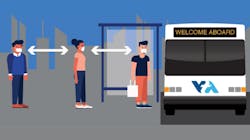Santa Clara VTA publishes 10-point plan to strengthen trust in transit
The Santa Clara Valley Transportation Authority (VTA) created an internal recovery task force to craft a plan to ensure riders feel confident during the pandemic.
With ridership and funding down significantly, and the temporary suspension of fare collection, Santa Clara VTA reduced service to a more reliable operating level. Over the past several weeks and months, additional protections have been put in place for bus and train operators and passengers as ridership appears to be increasing gradually. Service has also started to increase incrementally and, with the new protections in place, Santa Clara VTA plans to resume fare collection on Aug. 1.
To ensure returning riders can be confident in the system, Santa Clara VTA is taking the following 10 steps:
1. Clean and sanitize vehicles and facilities
Santa Clara VTA has enhanced cleaning efforts based on CDC recommendations and, along with all the region’s transit agencies, by utilizing industry best practices. Buses, trains, Access Paratransit vehicles and transit facilities are cleaned every day, and frequently touched surfaces are disinfected throughout the day using CDC-approved cleaning products.
2. Require face coverings
The state of California and Santa Clara County have made it mandatory to wear a face covering while riding transit. Passengers cannot ride Santa Clara VTA without one unless exempt.
3. Safely distance
Health officials recommend maintaining a safe distance from others. Please spread out while waiting for transit and on buses and trains, except when with people from the same household.
4. Maintain a healthy workforce
All Santa Clara VTA employees are provided protective and safety equipment and supplies to do their jobs safely. As essential workers, employees receive priority COVID-19 testing and are required to stay home if sick.
5. Adjust service frequency/hours based on demand
As shelter-in-place restrictions are eased over time, the agency is working with employers and educational institutions on return-to-work and school reopening plans to adjust service. The agency is operating “COVID Service” and will continue to adjust through 2020. The agency says it will seek public input as it develops the 2021 Transit Service Plan.
6. Protect operators and passengers
Santa Clara VTA implemented rear-door boarding to safeguard passengers and operators and is installing operator partitions to limit contact. In addition to partitions, operators are provided a variety of protective equipment, including face masks, face shields and other items to be worn as appropriate when helping passengers.
7. Increase contactless payment/fare collection
Santa Clara VTA paused fare collection to reduce the interaction between operators and passengers. To reduce surface touch points on transit when fare collection resumes, consider downloading VTA’s EZfare app or get a Clipper Card and load funds online in advance instead of paying cash at the farebox.
8. Increase customer information
Customer service representatives are available by phone and email to help with trip planning needs. The Transit app is recommended for real-time service updates and automated information can be accessed at 408-321-2300 in multiple languages. Updates will continue to be provided at www.vta.org/covid-19.
9. Adopt new technology and industry methodology
The agency says it is closely monitoring industry best practices and exploring new technologies to stop the spread of COVID-19. New methods will be evaluated and implemented when proven to be effective and suited to Santa Clara VTA operations.
10. Enhance community partnerships
Work continues with Santa Clara County, public health officials and community-based organizations to engage and inform underserved, underrepresented and unhoused populations. This collaboration will enhance communications with all those the agency wishes to welcome back to transit.
